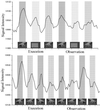Reafferent copies of imitated actions in the right superior temporal cortex
- PMID: 11717457
- PMCID: PMC61155
- DOI: 10.1073/pnas.241474598
Reafferent copies of imitated actions in the right superior temporal cortex
Abstract
Imitation is a complex phenomenon, the neural mechanisms of which are still largely unknown. When individuals imitate an action that already is present in their motor repertoire, a mechanism matching the observed action onto an internal motor representation of that action should suffice for the purpose. When one has to copy a new action, however, or to adjust an action present in one's motor repertoire to a different observed action, an additional mechanism is needed that allows the observer to compare the action made by another individual with the sensory consequences of the same action made by himself. Previous experiments have shown that a mechanism that directly matches observed actions on their motor counterparts exists in the premotor cortex of monkeys and humans. Here we report the results of functional magnetic resonance experiments, suggesting that in the superior temporal sulcus, a higher order visual region, there is a sector that becomes active both during hand action observation and during imitation even in the absence of direct vision of the imitator's hand. The motor-related activity is greater during imitation than during control motor tasks. This newly identified region has all the requisites for being the region at which the observed actions, and the reafferent motor-related copies of actions made by the imitator, interact.
Figures


References
-
- James W. Principles of Psychology. New York: Holt; 1890.
-
- Arbib M A, Rizzolatti G. In: The Nature of Concept: Evolution, Structure and Representation. Van Loocke P, editor. London: Routledge; 1999.
-
- Kawato M. Curr Opin Neurobiol. 1999;9:718–727. - PubMed
-
- Wolpert D M, Ghahramani Z. Nat Neurosci. 2000;3:1212–1217. - PubMed
-
- Greenwald A G. Psychol Rev. 1970;77:73–79. - PubMed
Publication types
MeSH terms
Grants and funding
LinkOut - more resources
Full Text Sources

